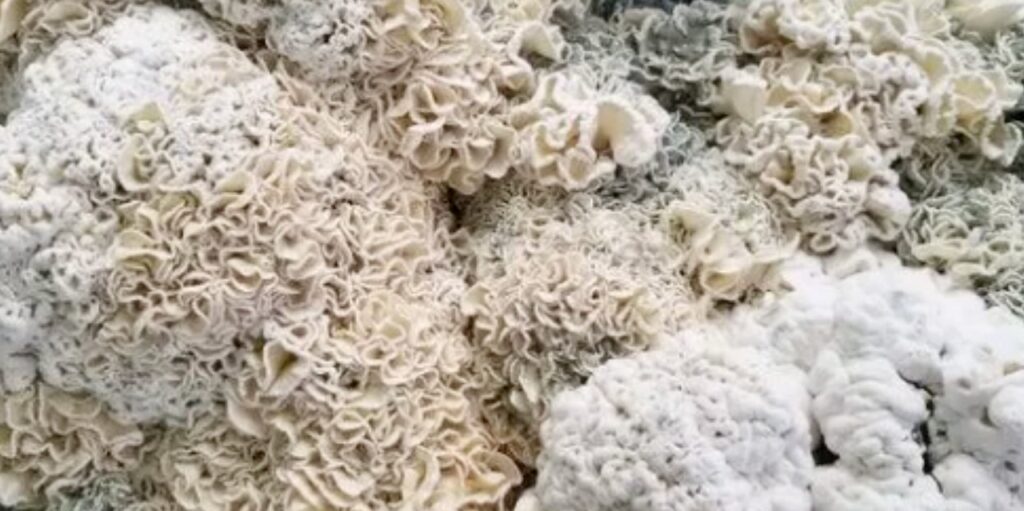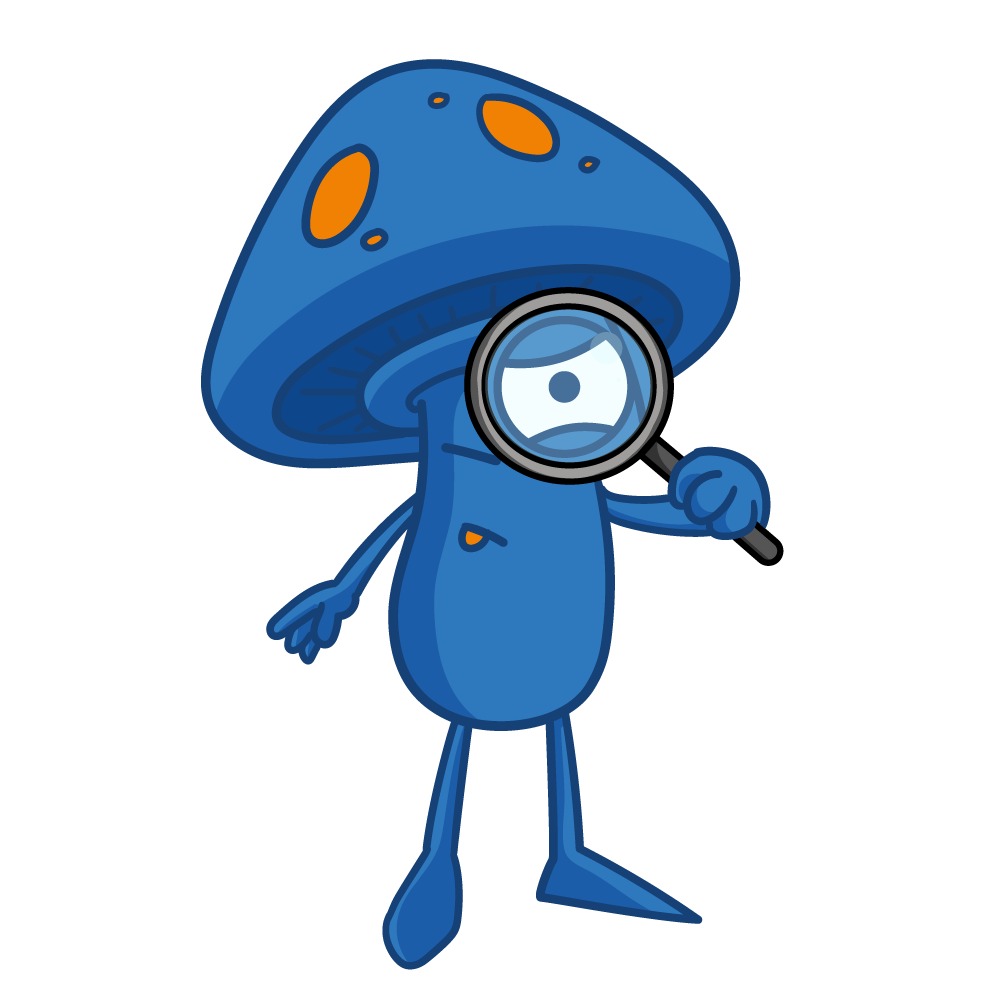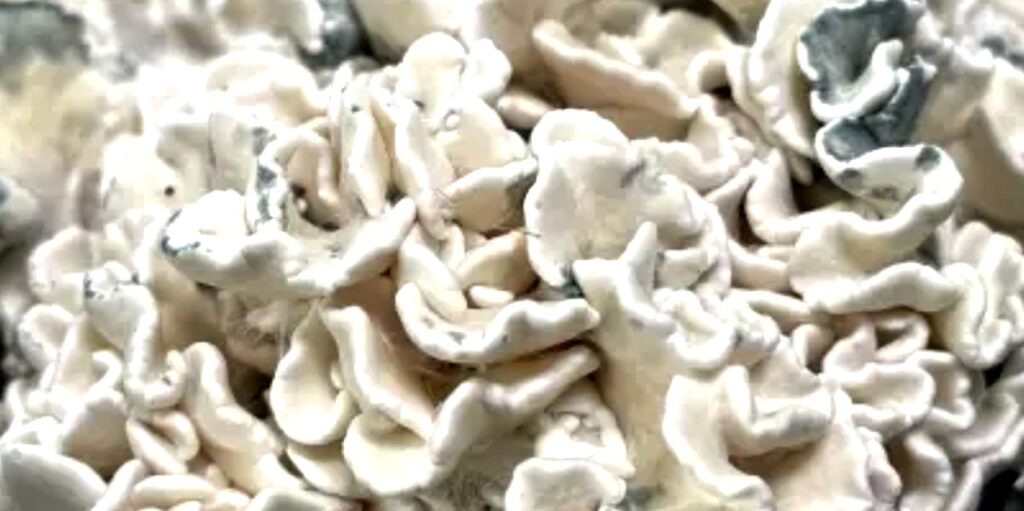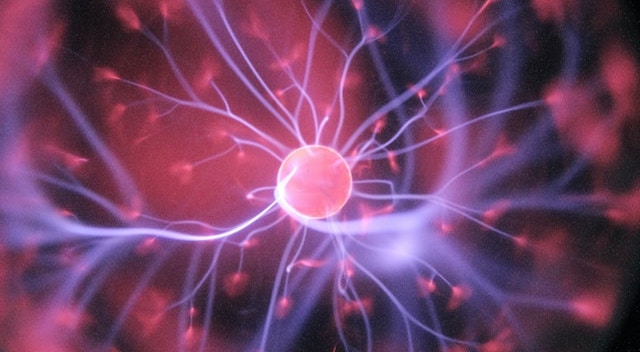But, the mushroom that actually goes by the name Enigma, appropriately enough, really takes the cake. An undulating, brain-like mass of cryptic origin, this mushroom truly lives up to its moniker.
Because of this, it probably won’t surprise you to learn that the Enigma mushroom is one of the more mysterious strains of the psilocybin family. And, as tends to happen with rare and mysterious things, they become sought after, especially when they have potent psychedelic qualities.
What is the Enigma Mushroom?
Enigma mushrooms are a mutant form of the much-loved Psilocybe cubensis magic mushroom. Rather Frankenstein-esque in its origin, it is not technically a ‘strain’. It is, in fact, the result of crossbreeding two mushroom types that wouldn’t naturally reproduce together. Their bizarre “blob mutation” leads to their characteristic unusual growth pattern. A result of this is that the Enigma cannot produce spores, meaning it is sterile; rather like when you breed a horse with a donkey, and end up with a mule. This means that there is only one generation of the Enigma mushroom — it can only be reproduced through cloning. A thoroughly human intervention.

Hyphae Labs co-founder Ian Bollinger, on the subject of the enigma mushroom, told DoubleBlind magazine;
“Enigma is not necessarily a cultivar, so much as it is a body type or morphology,”
He added;
“The first Enigmas that were popularized were induced by causing two different mating types that would not normally mate with each other to mate,”
The Origin of the Enigma Mushroom

While the exact origin story of the enigma is, appropriately enough — an enigma — there are some whispers and legends that persist amongst the shroom community. What most people can agree on is that this mutation did not happen in a natural environment. It was certainly human intervention that brought this shroom into being. The mutation of Enigma comes down to external factors that are very unlikely to be present naturally. This kind of mutation is not just observed in P. cubensis, it can also happen in other mushroom types. Not a specifically bred strain, but a purposeful cross-breeding or mutation of two mating types that would never have ‘come together’ let’s say, naturally. Enigma is thought to be an isolated mutation of the ‘Tidalwave’ cubensis strain, itself the product of breeding the B+ and Penis Envy strains.
In general, different types, offshoots, and variants of the P. cubensis are pretty hard to tell apart based on looks alone. But, the Enigma once again bucks this trend. Perhaps due to the natural incompatibility of its parents, this mutation looks distinctly different to the rest of the magic mushroom clan.
Enigma Mushroom Characteristics
Enigma mushrooms are characterized by a blob-like form that is reminiscent of lumpy, gray, brain matter. It doesn’t produce a cap, spores, or have the ability to make a viable fruiting body.
Reggie Harris, the other founder of Hyphae Labs, and a pioneer in the psilocybin potency-testing field had this to say to DoubleBlind magazine about the bizarre shroom;
“If conditions aren’t one-hundred percent perfect above the surface, what the mushrooms will do is produce mutations of mycelium mat under the surface called sclerotia, also known as truffles,”
In the case of the Enigma he explained, it appears as “surface-level sclerotia.” This is unusual, as this part of the mushroom is usually unseen, beneath the ground. As the sclerotia creeps to the surface of the substrate, it produces these curls and folds that make the Enigma novel. It tends to grow in thick clusters, slowly, in shades of white or blue-ish.

What’s The Potency of the Enigma Mushroom?
Some people claim that Enigma mushrooms have higher potency than other strains of P. cubensis — even the feted Penis Envy mushroom. However, it’s not so simple. As with any psychedelic mushroom the potency depends on various factors, including the growing conditions and its external environment.
In the most recent results from the Oakland Hyphae Cup Report, which compares and analyzes many lab-tested mushroom strains, there were three different Enigma mushrooms featured.
One shroom, named Enigma B had the impressive potency of 9.3 milligrams of psilocybin per gram. Another, Enigma Tony contained 8.4 milligrams of psilocybin per gram. A pretty intense fungus, huh? However, as a testament to how much environmental and growing factors can influence potency, the other Enigma strain, called Enigma Revert, contains just 1.8 milligrams of psilocybin per gram.
Online shroom forums and threads are awash with discussion about the relative potency of the Enigma mutation. However, this aside, it is important to exercise caution when exploring a new strain of magic mushroom. Especially one that seemingly has the potential for such a range of psychedelic strength.
How to Grow Enigma Mushrooms
As per other P. cubensis strains, Enigma mushrooms have their own likes and dislikes when it comes to growing conditions. Common factors that will influence their growth include temperature, humidity, substrate and growing mediums.

As Harris explains, the preferred substrate for the Enigma mushroom include gypsum and coconut coir. These materials provide the vital nutrients and environment for the mycelium to colonize the substrate and thrive.
Enigma mushrooms are said to do best in a temperature range of 24-27°C (75-81°F) during colonization. During the harvesting stage they prefer a slightly lower 21-24°C (70-75°F). The optimal humidity for the early stages of cultivation are around 95-100%.
(On a side note, the Enigma can actually withstand slightly lower temperatures, due to its concertina-like mutated form, when compared to most other P. cubensis variants.)
Slow and Steady
According to Harris, on average the full cultivation process takes about a month longer than the average cubensis strain. The Enigma certainly requires some extra attention and patience. From the beginning of the inoculation process to harvesting, growers find that it can take between 6 to 8 weeks.
Bollinger adds that the Enigma mushroom tends to be a more volatile cultivation project than your standard cubensis. It is not unusual to see a range of different outcomes. This can run the gamut from exciting to frustrating for growers.
Enigma mushrooms can only be bred and propagated through cloning, unlike others in the P. cubensis family. The only way to get your hands on Enigma mushrooms is from a culture passed down from the original mutation, either through a syringe or plated mycelium.
A Riddle within a Riddle
So, the Enigma mushroom — a beguiling and bizarre member of the psychedelic mushroom family, that fascinates mushroom cultivators, psychedelic fans, and mycologists alike.
Although it’s hard to obtain, many say that the Enigma is definitely a trip worth embarking on. The word ‘enigma’ derives from an Ancient Greek word that means “to speak in riddles”. In many ways a psychedelic trip is like a riddle. The puzzle of ourselves, our psyche, and deepest desires opened up for exploration through natural magic. Embrace the mystery!






